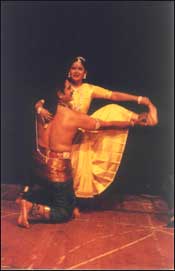Kamasutra, A Kuchipudi Dance Ballet

Kamasutra, A Kuchipudi Dance Ballet is an event that took place on 25-Nov-2003 in Hyderabad.
-
Venue
-
Date/Time
-
Price
-
Venue Website
-
Add New Field:
When Vatsayana wrote the Kamasutra, condom promos were possibly the last thing on his mind. But they're most likely the first thing in most of ours when we think Kamasutra (okay, maybe not the first thing). So when Swathy Somanath decided to make a dance ballet of the book that altered perception about India everywhere, there were gasps from contemporary artistes and much tut-tutting from Kuchipudi puritans. Impurifying our sacred dance form by introducing sex into it? What is the world coming to?
"If half of them knew the meaning of the Sanskrit verses that you hear during most dance recitals, they would drop dead from embarassment," says Somanath, "We're happily unaware of the level of eroticism in our ancient literature." And Somanath has no intention of encouraging this ignorance.
The Kamasutra, she says, stressed the importance of a good sex life, which, apart from being fun in itself, also protects the marriage and keeps the partners from straying. At least that is the theory. Kamasutra doesn't introduce an alien element into our sacred culture, it only celebrates the sex that was always there.
For all its potential sensationalism, Somanath's ballet conforms to the common code of discipline and aesthetics as laid down in the natyashastras. The dance serves to articulate an idea, not titillate the audience.
The last time she performed the Kamasutra, all the publicity material for the event placed the word 'Kuchipudi' modestly at the bottom of the poster. But after protests from senior artistes to remove the word altogether from the ads, the promos now read - Swathy Somanath presents the KUCHIPUDI Dance Ballet 'Kamasutra'.
Be there - you might learn a thing or two.
The ballet is being performed for the cause of the twin cities' street children. For further details please contact 2700-3890.
Be the first to comment on Kamasutra, A Kuchipudi Dance Ballet! Just use the simple form below.
LEAVE A COMMENT
fullhyd.com has 700,000+ monthly visits. Tell Hyderabad what you feel about Kamasutra, A Kuchipudi Dance Ballet!
MORE EVENTS IN THIS PERIOD
ALL EVENT CATEGORIES
SEARCH EVENTS
Dissatisfied with the results? Report a problem or error, or add a listing.
ADVERTISEMENT
SHOUTBOX!
{{ todo.summary }}... expand »
{{ todo.text }}
« collapse
First | Prev |
1 2 3
{{current_page-1}} {{current_page}} {{current_page+1}}
{{last_page-2}} {{last_page-1}} {{last_page}}
| Next | Last
{{todos[0].name}}
{{todos[0].text}}
ADVERTISEMENT
This page was tagged for
hyderabad animal womenssex vidoes
ameerpet hostels for womenssex
lakdi kamsutra
Kamasuthrapossion.com
www.womenssextelugu